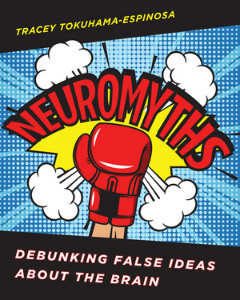Debunking Myths About How the Brain Learns
Neuromyths: Debunking False Ideas About the Brain
By Tracey Tokuhama-Espinosa
(W.W. Norton & Co., 2018 – Learn more)
Reviewed by Mary K. Marsh
With more and more publishers claiming their curriculum is based on brain science, and the emergence of professional development presentations promoting brain-based learning approaches, Tracey Tokuhama-Espinosa’s Neuromyths: Debunking False Ideas About the Brain is a sobering and timely reminder that claims of being brain-friendly are not always actually supported by neuroscience.

Confusions about how the brain operates create confusions about how students learn. Well-intended teachers then may rely on faulty ideas. By dismantling these neuromyths, Tokuhama-Espinosa attempts to help teachers understand why each myth emerged as well as what the actual neuroscience is.
Letting go of widely accepted myths
Some neuromyths, such as “There Are Brain Differences Based on Race” and “Your Brain Will Shrink If You Don’t Drink Six to Eight Glasses of Water a Day,” likely will be easy for most teachers to give up (if they even actually held those beliefs).
Others, such as “Some People Are More ‘Right Brained’ and Others are More ‘Left-Brained’’’ and “Individuals Learn Better When They Receive Information in Their Preferred Learning Styles,” may prove more difficult to let go. The pervasiveness and persistence of a Left Brain/Right Brain distinction and Visual-Auditory-Kinesthetic learning preferences could make it difficult for many teachers to relinquish those neuromythologies.
Yet, these ideas may be the ones most limiting our instructional choices. As Tokuhama-Espinosa writes, “People cannot limit perception to a single sense. The brain is extremely efficient. All new learning comes from the senses as the brain hungrily seeks as much information as it can from all its perception modes, all the time.” (p. 56) Neuromyths actually narrow instructional choice, while understanding the real neurological interconnections of the brain expands options for teaching.
A need to rethink rather than discard some practices
At times Neuromyths takes aim at ideas like some within early childhood education including the importance of the first three years and enriched learning environments because they do not meet the strict neuroscience evidence criteria Tokuhama-Espinosa requires. They are labeled as neuromyths even though she admits the ideas may have support from other disciplines.
Therefore, as teachers we need to be clear with ourselves when we are using an idea because it has a foundation in neuroscience and when we are using an idea because it has a foundation well-supported by other evidence. While many of the neuromyths in the book lead to educational practices that should be discarded, other neuromyths actually just need to be better understood or valued not as neuroscience but with an alternative basis.
A highly structured look at neuromyths
The book organizes neuromyths into ten broad categories of myths. Each of the chapters presents a series of corresponding neuromyths for that category. Each neuromyth is then examined in the pattern of a short explanation of the myth’s assertion, followed by “Where the Myth Comes From” and “What We Know Now” sections. A “Why This Is Good News for Teaching” section ends each chapter.
While the information is clear, the rigid structure and meticulous footnoting can make Neuromyths feel monotonous at times. The supporting graphics were monotone and a bit underwhelming. And the large number of myths itself became overwhelming at times. The book is a worthwhile read; just be aware it feels more like reading a textbook and it may be better to break it up into numerous reading sessions.
Separating fact from fiction
Perhaps the most valuable understanding to emerge from Neuromyths is less about any particular neuromyth and more about understanding the need to distinguish between fact and appealing fiction as neuroscience is applied in education. In the book’s takeaway chapter, Tokuhama-Espinosa provides a list of things teachers can do to guard against falling for neuromyths.
However helpful she might have meant her list to be, I have to admit to feeling more discouraged than encouraged by being told I now need to pursue scientific literacy to thoroughly investigate every bit of information I consider using in my classroom.
I actually enjoy reading about how the brain works and learning happens! Of course, I want to be thoughtful in my practice and choice of strategies, and that’s the reason I seek out opportunities to read professional development books, but I would have appreciated it if Neuromyths discussed more what to do than what not to do.
What really makes an approach neurologically based
Neuromyths serves as important reference for teachers who want to sort through all the competing claims before jumping on the brain-based bandwagon. It sharply distinguishes between neurological fact and supposition. As such, it provokes teachers into questioning what really makes an approach neurologically based. It reveals the complexity of the neurologic processes for learning and encourages teachers to embrace the messy promise of learning neuroscience.
Currently Mary K. Marsh teaches middle school social studies in Bellbrook, OH. She is also a reading specialist trained in Reading Recovery.




































